Yamaha 2021 Aventage AVR line-up: everything you need to know
Yamaha's new AV receiver range explained
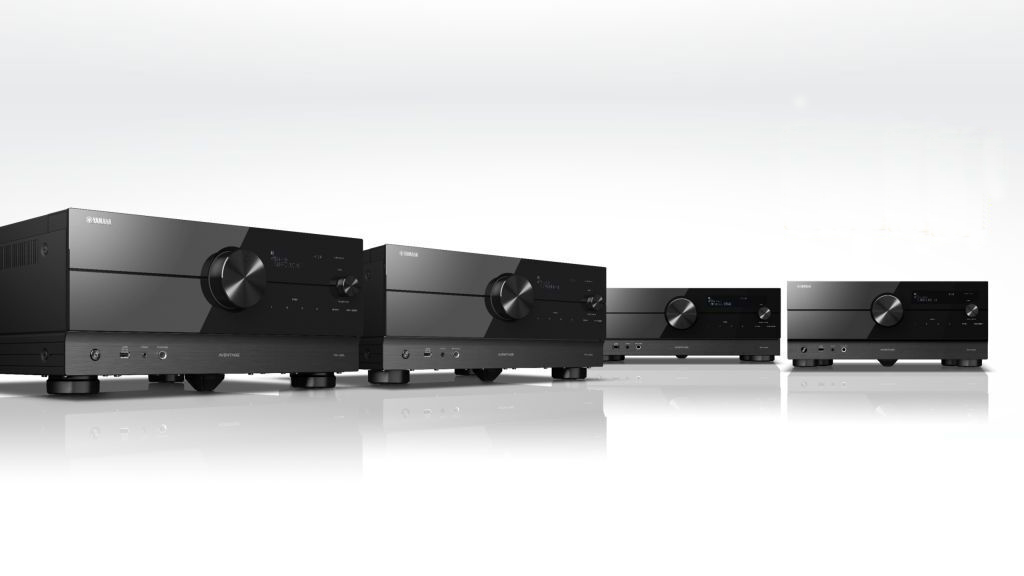
First launched in 2010, Yamaha’s Aventage series of AV receivers sit at the top of the company’s range and benefits from the very latest features and highest quality components that Yamaha has to offer. Born from rethinking every element of the company’s traditional receiver designs, Aventage gained instant success and has been refined every generation by iterative improvements. For example, we've seen Dolby Atmos height channels and Yamaha’s MusicCast streaming multiroom platform added in recent years to broaden their appeal.
After unveiling the RX-A2A AV receiver at the end of 2020, Yamaha announced three further models would make up the rest of the Aventage home cinema amplifier range. These amps are due to launch in August 2021.
The Yamaha Aventage RX-A8A, RX-A6A and RX-A4A are all set to offer seven HDMI 2.1 inputs and three outputs supporting 8K@60Hz/4K@120Hz, Dolby Atmos, DTS:X and Auro 3D audio (A8A and A6A only), plus plenty of tech including AirPlay 2, Spotify Connect and built-in Amazon Alexa voice assistant compatibility. The trio of home cinema amplifiers will also feature Yamaha's 'Surround: AI' tech, which uses algorithms to automatically select the best digital processing mode depending on the type of content being played.
Want to know everything about Yamaha's 2021 Aventage range? Allow us to run through all of the highlights and break down the details of the models in the line-up to find out which is the one that suits your needs.
Design
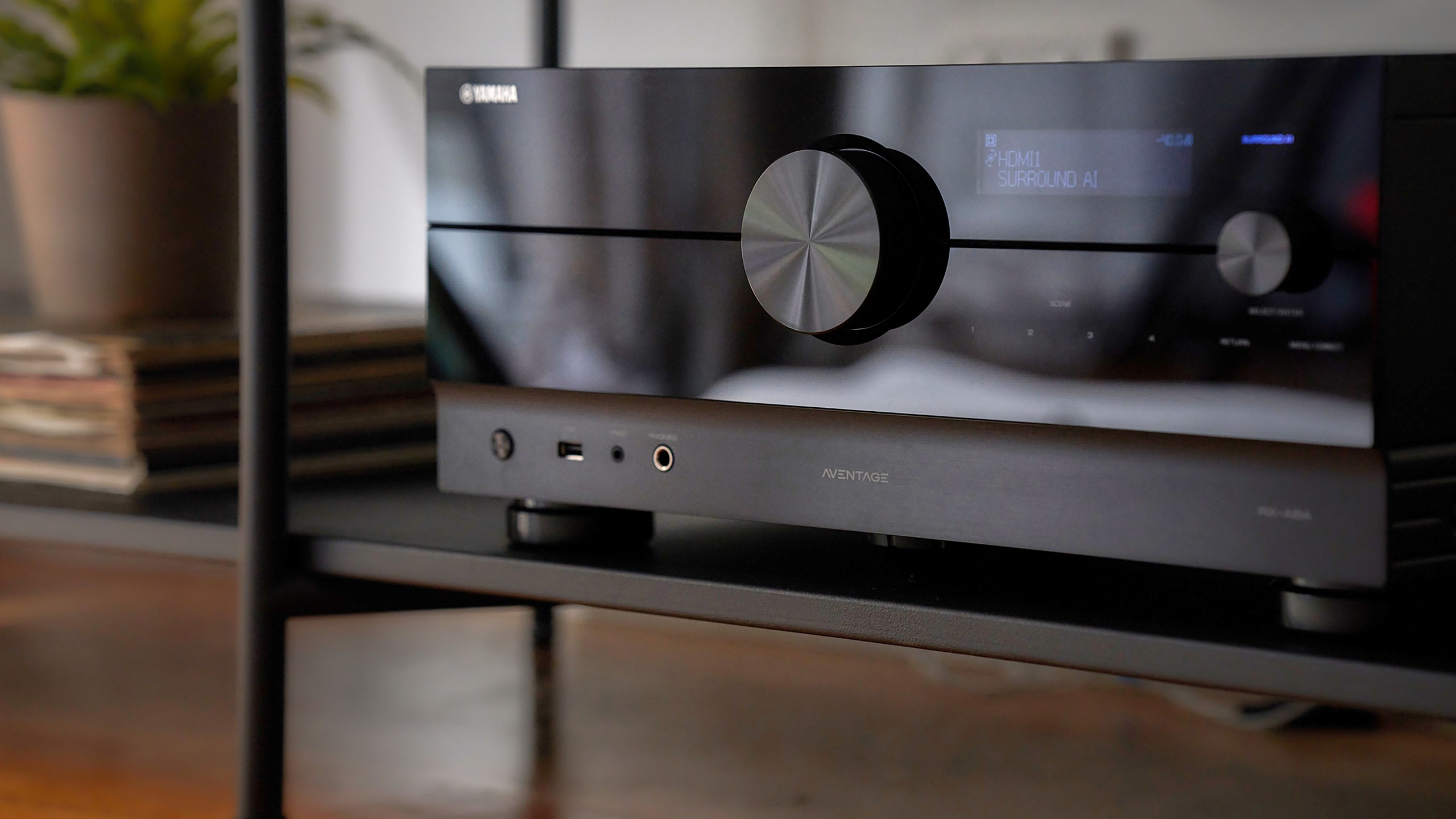
There has been a distinct restyling for the Aventage 10 range that echo's last year's entry-level RX-V series. Out goes the wide central display with small lights and logos, and in comes a larger main volume knob positioned dead centre with a brand new, high-resolution LCD display on the right.
Also gone is the big flap hiding front inputs and controls. The only front-panel sockets remaining are a full-size headphone jack, a USB-A port with 5V charging, and a mini-jack into which the microphone plugs for Yamaha’s YPAO auto-calibration. The change in layout hasn't just been aesthetic; removing front inputs has allowed Yamaha to create a more solid metal structure beneath the front panel to help improve stability and resistance to vibrations.
The new build includes a revamped internal circuit design and upgrades to the mechanical structure and audio parts, including Premier Audio DACs from SABRE.
The amplifier layout has been made more symmetrical to optimise signal paths and improve sound clarity while reducing signal noise and interference. A new internal H-frame structure claims to add to chassis rigidity.
In addition, Yamaha's signature Anti-Resonance Technology wedge (A.R.T), known as the Aventage’s ‘fifth foot’, has been shifted further forward and modified for more efficient dispersion of chassis vibration in the top three new models. All these improvements, Yamaha says will help in “providing dynamic sound and focused accurate reproduction”.
Qualcomm chipset
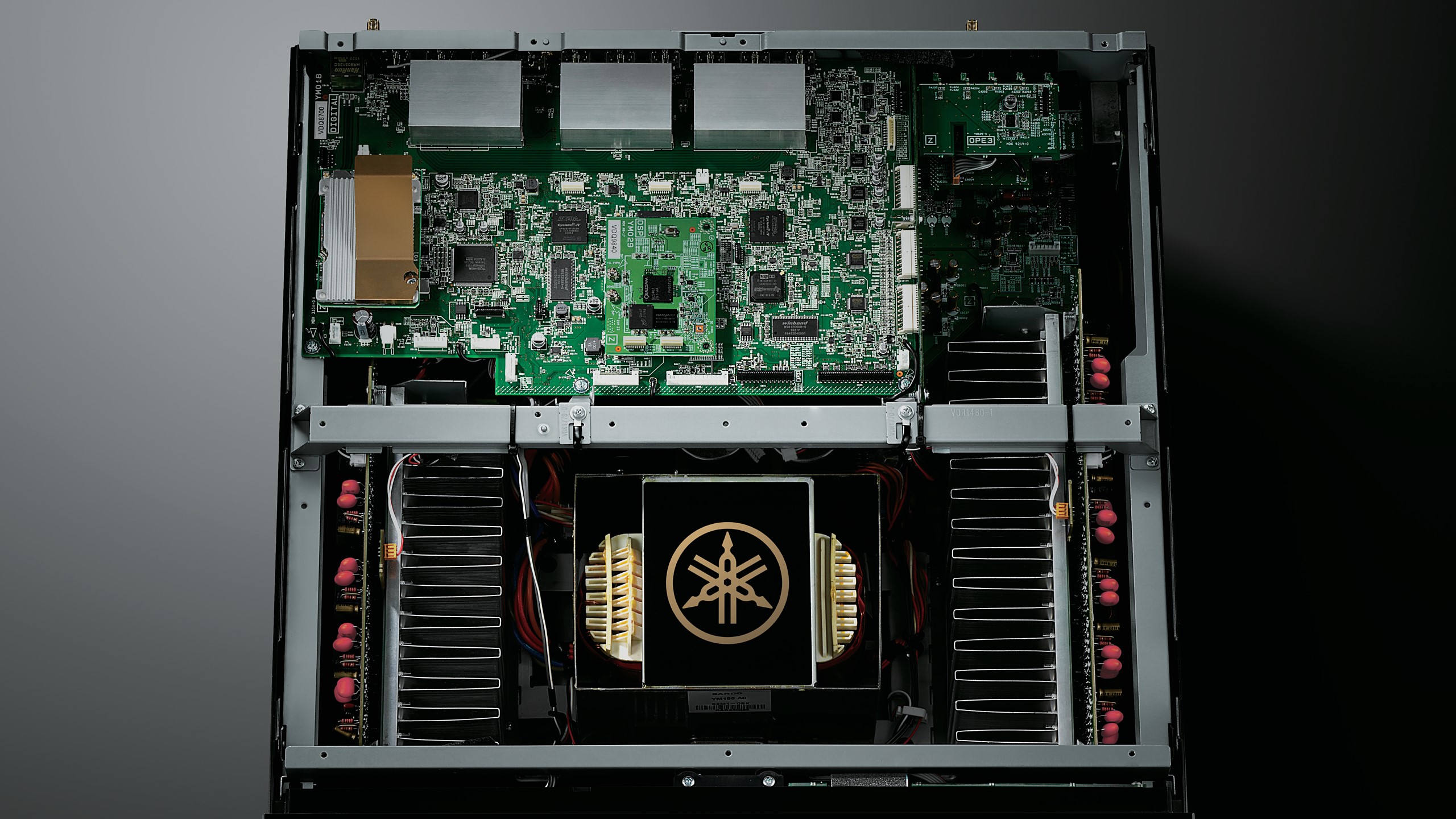
Dolby Atmos, DTS:X and Dolby Atmos with Height Virtualization in the top three Aventage models will be powered by a new Qualcomm 64-bit chipset that Yamaha says will offer improved sound quality.
In the A8A, A6A and A4A, this also means that there is the capacity to support Surround: AI, Yamaha's own immersive sound technology that analyses the type of content being watched – such as dialogue, ambience, action – five times every second and then auto-applies the most suitable audio mode, from a selection of more than 24 DSP (digital soundfield processing) programs.
The top two models will also offer the Auro 3D surround format, which uses height channels that are not directly overhead, and the Auromatic upmixing algorithm after a software update due in the autumn.
The extra processing power of the new chipset will allow for more accurate 64-bit measurements when using Yamaha's own Parametric room Acoustic Optimizer (YPAO) calibration with R.S.C (Reflective Sound Control) and multi-point measurement, precision EQ and a new low-frequency mode. This new mode extends the range to which YPAO can optimise bass frequencies to 16Hz-200Hz (from 32Hz previously) and can be found in the top three models.
Yamaha says that Qualcomm has surplus capacity and a field-programmable gate array, meaning it can provide significant future upgrades via software updates and long term value for money. This brings us to...
HDMI 2.1 ...but not out of the box
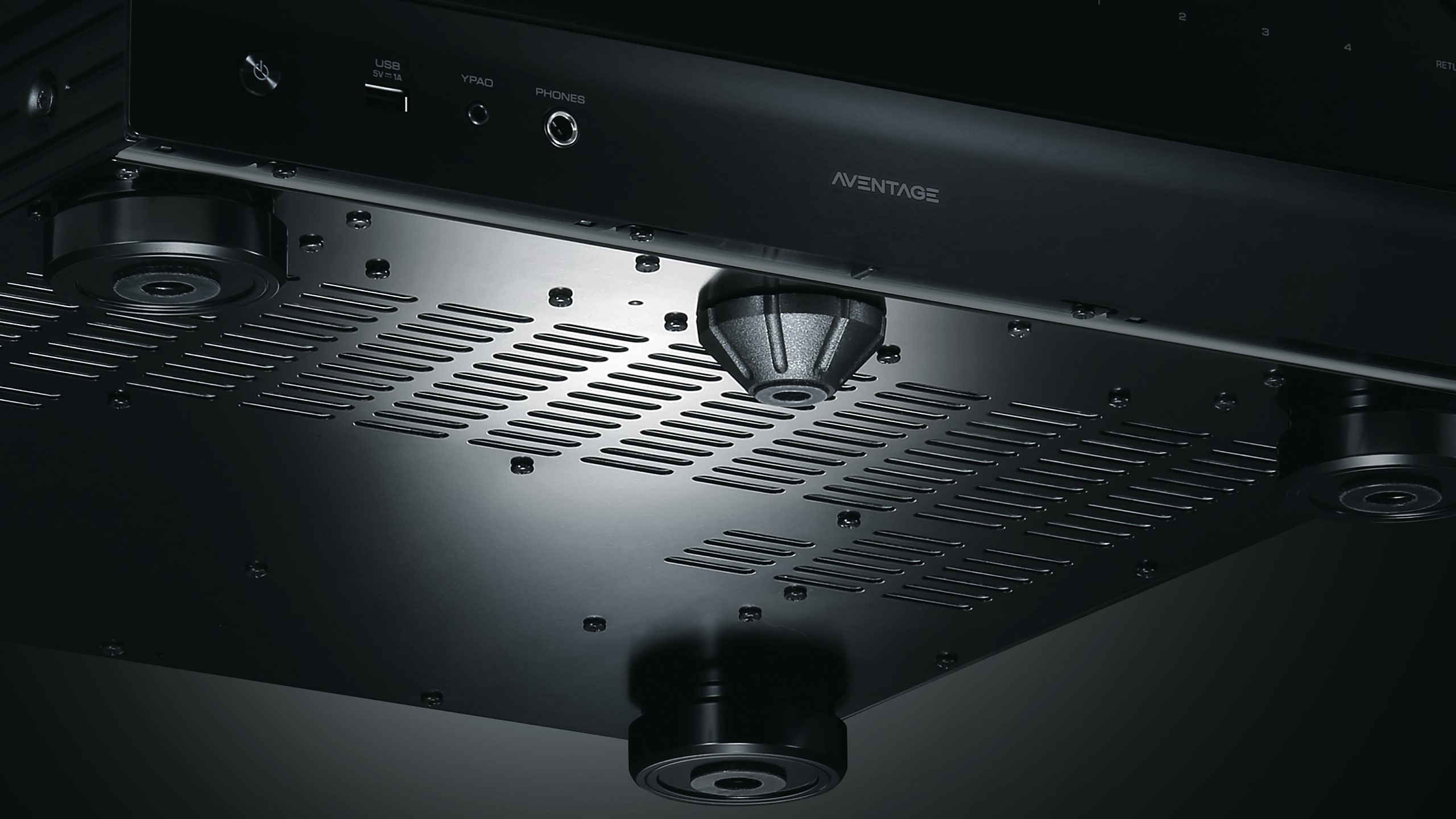
First, a bit of backstory on the HDMI 2.1 AVR saga.
Earlier this year, it was revealed that Yamaha's 2020 flagship AV receivers were blighted by a faulty HDMI 2.1 chip that meant some units couldn't support 4K gaming at 120Hz. Unfortunately, the same HDMI 2.1 glitch also affected Denon and Marantz's 2020 8K AV receivers; however, while those models received a slightly awkward hardware fix in April, Yamaha users have not yet been offered a solution.
Along with retrograde software and hardware updates to its affected 2020 models (including the A2A), Yamaha has confirmed that the new A8A, A6A and A4A will all offer full HDMI 2.1 compatibility via a series of firmware updates due after the products launch.
The A8A, A6A, A4A and A2A will all receive support for uncompressed 4K@120Hz and HDR10+ during the autumn of 2021. In addition, the top three models will also gain uncompressed 8K@60Hz functionality and HDMI upscaling up to 8K at around the same time. Given that the release date for the three new models is loosely set at late August, the wait for these full-fat HDMI 2.1 features should only be a couple of months.
Meanwhile, upgrades for enhanced gaming features such as 4K and 8K Display Screen Compression modes, Auto Low Latency Mode (ALLM), Variable Refresh Rate (VRR), Quick Media Switching (QMS) and Quick Frame Transport (QFT) are also forthcoming but crucially do not yet have a release date as Yamaha is awaiting test specifications from HDMI.org.
Yamaha RX-A8A (£3299/$3000/AU$6299)
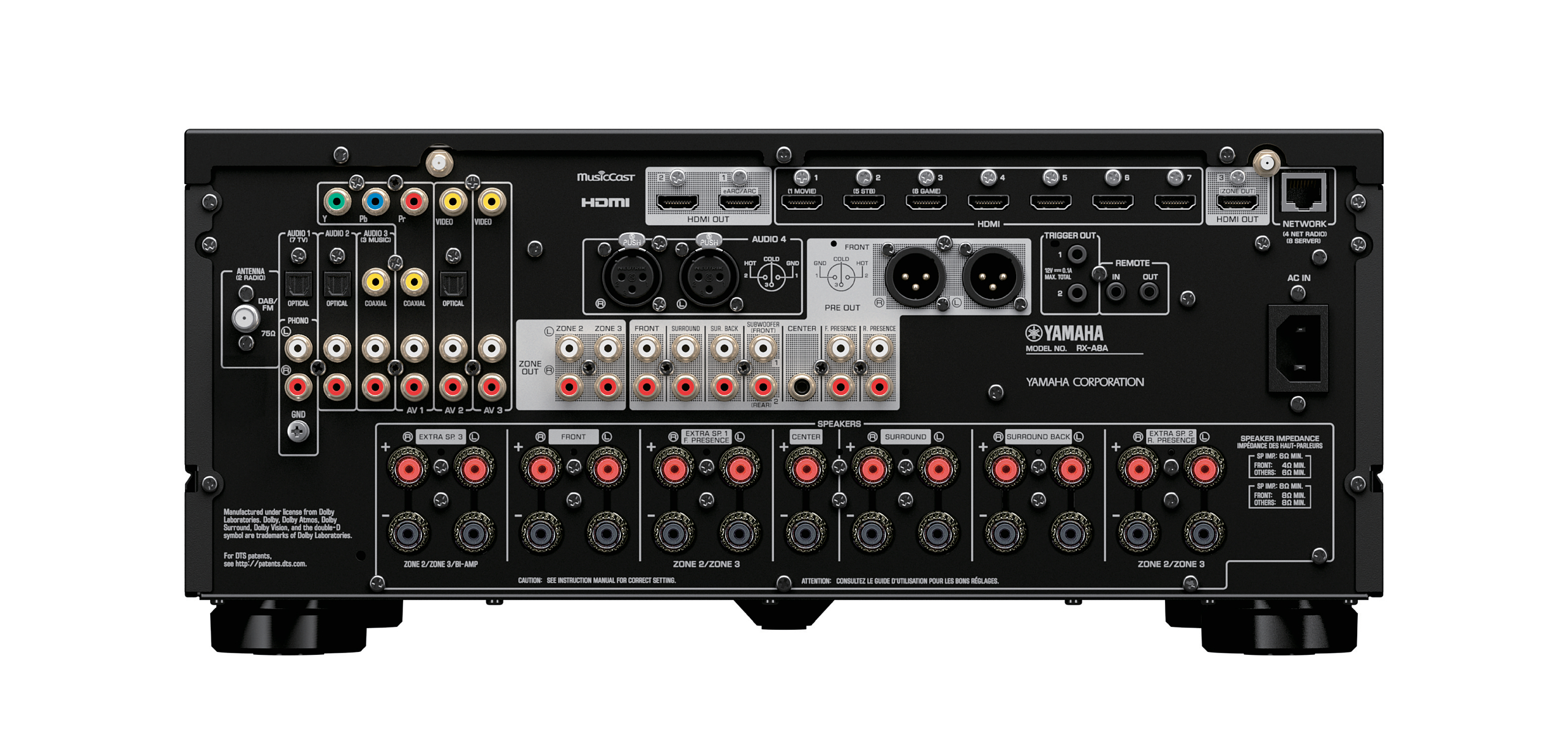
The Aventage 10 flagship AV receiver is the Yamaha RX-A8A, with 11.2 amplified channels, a claimed power rating of 150 watts per channel in stereo, and like the rest of the range, it uses new high-slew amplification technology that offers twice the accuracy of previous amps, according to Yamaha.
Unlike the rest of the range, the A8A features extra structural and circuitry tweaks such as complete separation of the transformer and power amplifiers, extra-large block capacitors and four power amp-support for vibration control. Its iron feet have been borrowed from the premium 5200 series and, for this model, the stabilising A.R.C wedge is made of sturdy brass.
Along with all of the 2021 Aventage AVRs, it offers a host of streaming options via MusicCast including wifi, AirPlay 2, Spotify Connect, built-in music streaming services (Amazon Music HD, Deezer, Napster, Pandora, SiriusXM, Spotify, Tidal and Qobuz), internet radio and multi-room audio as well as Bluetooth and an FM/AM/DAB Tuner.
The Yamaha RX-A8A is tentatively scheduled for release at the end of August with planned firmware updates due in autumn 2021.
- Channels: 11.2ch
- Power output in stereo conditions: 150W (8 ohm)
- High Slew Rate Amplifier: Yes
- Zones: 3
- HDMI: 7-in / 3-out with HDMI 2.1* / HDCP2.3
- HDMI Pass-through: 8K@60Hz*, 4K@120Hz*
- HDMI Up-scaling: Yes up to 8K*
- HDMI eARC: Yes
- HDR: Dolby Vision, HDR 10+*
- HDMI 2.1 features: VRR**/ALLM**/QMS**/QFT**
- Surround Sound Processing: Dolby Atmos, DTS:X, Dolby Atmos Height Virtualization, Surround: AI, Auro 3D*
- DAC: 384 kHz / 32-bit ESS Hyperstream DAC ES9026PRO x2
- Room Calibration: YPAO R.S.C. automatic room calibration with multi-point measurement, precision EQ and low-frequency mode
- Voice control: Amazon Alexa, Siri (via AirPlay 2) and Google Assistant
- Dimensions (hwd): 19 x 44 x 48cm
- Weight: 21.4 kg
Yamaha RX-A6A (£2299/$2200/AU$3699)
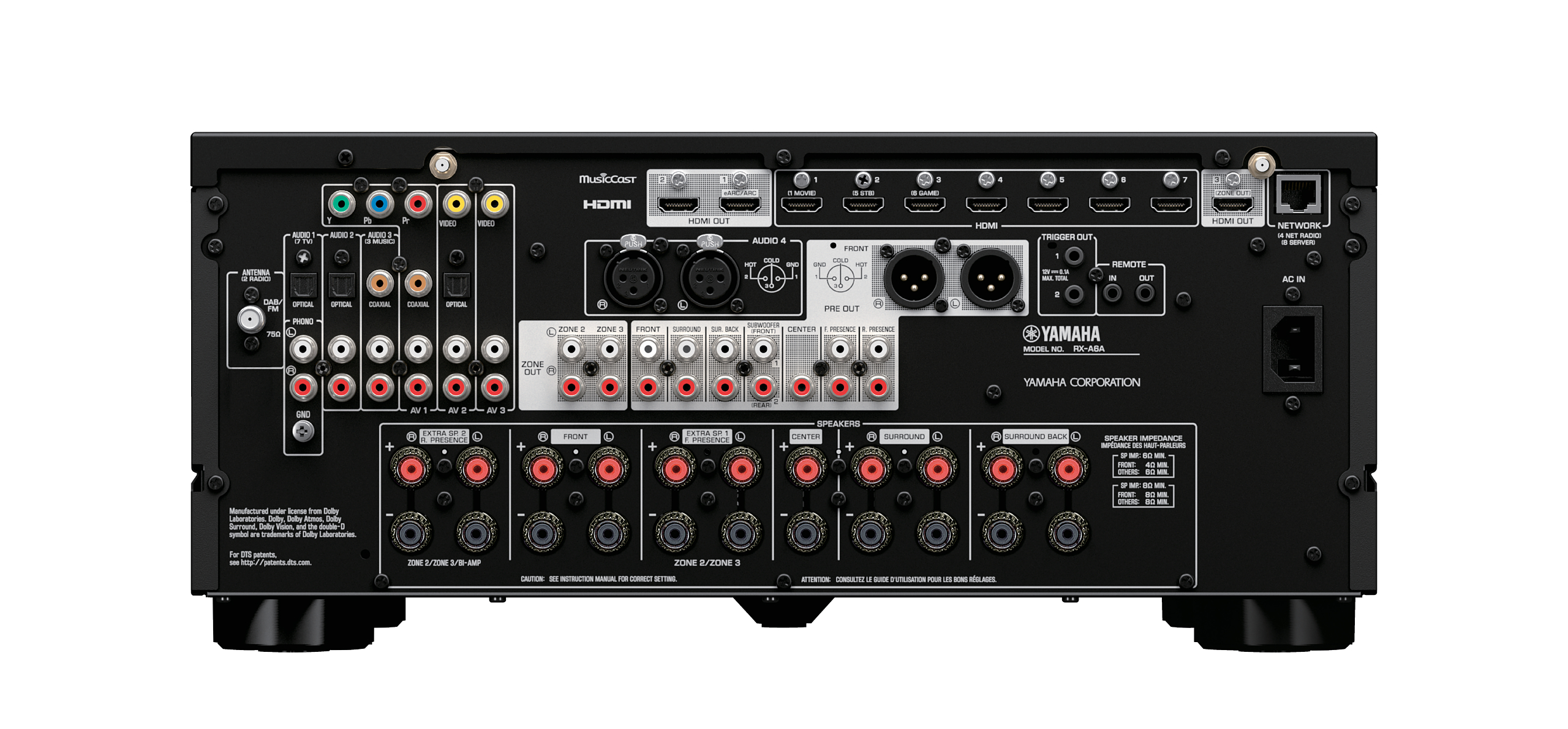
On the spec sheet, there's very little to distinguish the Yamaha A6A from the A8A other than its 9.2 channels. Most of the differences are internal: the A6A doesn't have the same separation between the transformer and power stages, extra-large custom block capacitors or the same level of structural damping as the A8A.
Additionally, while the A8A has dual 32-bit/384kHz ESS Hyperstream ES9026PRO DACs, the A6A only has one to handle the main channels while an ES9007S DAC takes care of the ambient channels.
Yamaha's RX-A6A is expected to be available from the end of August with planned firmware updates due in autumn 2021.
- Channels: 9.2ch
- Power output in stereo conditions: 150W (8 ohm)
- High Slew Rate Amplifier: Yes
- Zones: 2
- HDMI: 7-in / 3-out with HDMI 2.1* / HDCP2.3
- HDMI Pass-through: 8K@60Hz*, 4K@120Hz*
- HDMI Up-scaling: Yes up to 8K*
- HDMI eARC: Yes
- HDR: Dolby Vision, HDR 10+*
- HDMI 2.1 features: VRR**/ALLM**/QMS**/QFT**
- Surround Sound Processing: Dolby Atmos, DTS:X, Dolby Atmos Height Virtualization, Surround: AI, Auro 3D*
- DAC: 384 kHz / 32-bit ESS Hyperstream DAC ES9026PRO x1; ES9007S x1
- Room Calibration: YPAO R.S.C. automatic room calibration with multi-point measurement, precision EQ and low-frequency mode
- Voice control: Amazon Alexa, Siri (via AirPlay 2) and Google Assistant
- Dimensions (hwd): 19 x 44 x 44cm
- Weight: 20.3 kg
Yamaha RX-A4A (£1299/$1300/AU$2399)
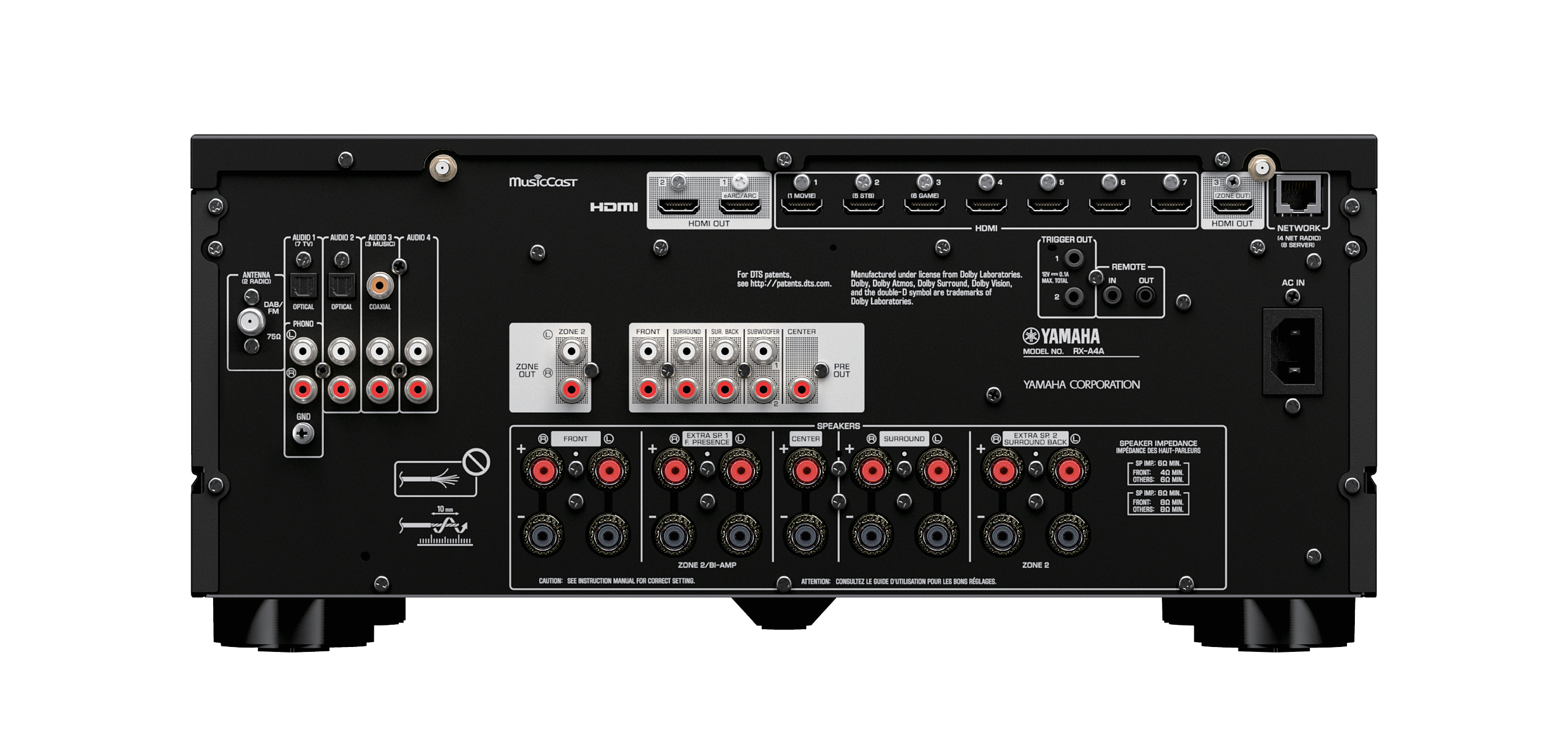
In addition to a step down in channels and power, the main departure to the Yamaha A4A involves the connectivity at the rear. It drops both an optical and a coaxial input compared to its big siblings, as well as two analogue inputs, and loses the pro-grade XLR sockets.
It maintains 7-in / 3-out with HDMI 2.1 ports and supports all the same audio formats as the more premium models, except Auro 3D, while video-wise there's no component or composite i/o.
The Yamaha RX-A4A is provisionally scheduled for release towards the end of August with planned firmware updates due in autumn 2021.
- Channels: 7.2ch
- Power output in stereo conditions: 110W (8 ohm)
- High Slew Rate Amplifier: Yes
- Zones: 2
- HDMI: 7-in / 3-out with HDMI 2.1* / HDCP2.3
- HDMI Pass-through: 8K@60Hz*, 4K@120Hz*
- HDMI Up-scaling :Yes up to 8K*
- HDMI eARC: Yes
- HDR: Dolby Vision, HDR 10+*
- HDMI 2.1 features: VRR**/ALLM**/QMS**/QFT**
- Surround Sound Processing: Dolby Atmos, DTS:X, Dolby Atmos Height Virtualization, Surround: AI
- DAC: 384 kHz / 32-bit ESS Hyperstream DAC ES9007S
- Room Calibration: YPAO R.S.C. automatic room calibration with multi-point measurement, precision EQ and low-frequency mode
- Voice control: Amazon Alexa, Siri (via AirPlay 2) and Google Assistant
- Dimensions (hwd): 19 x 44 x 44cm
- Weight: 16.2 kg
Yamaha RX-A2A (£899/$799/AU$1599)
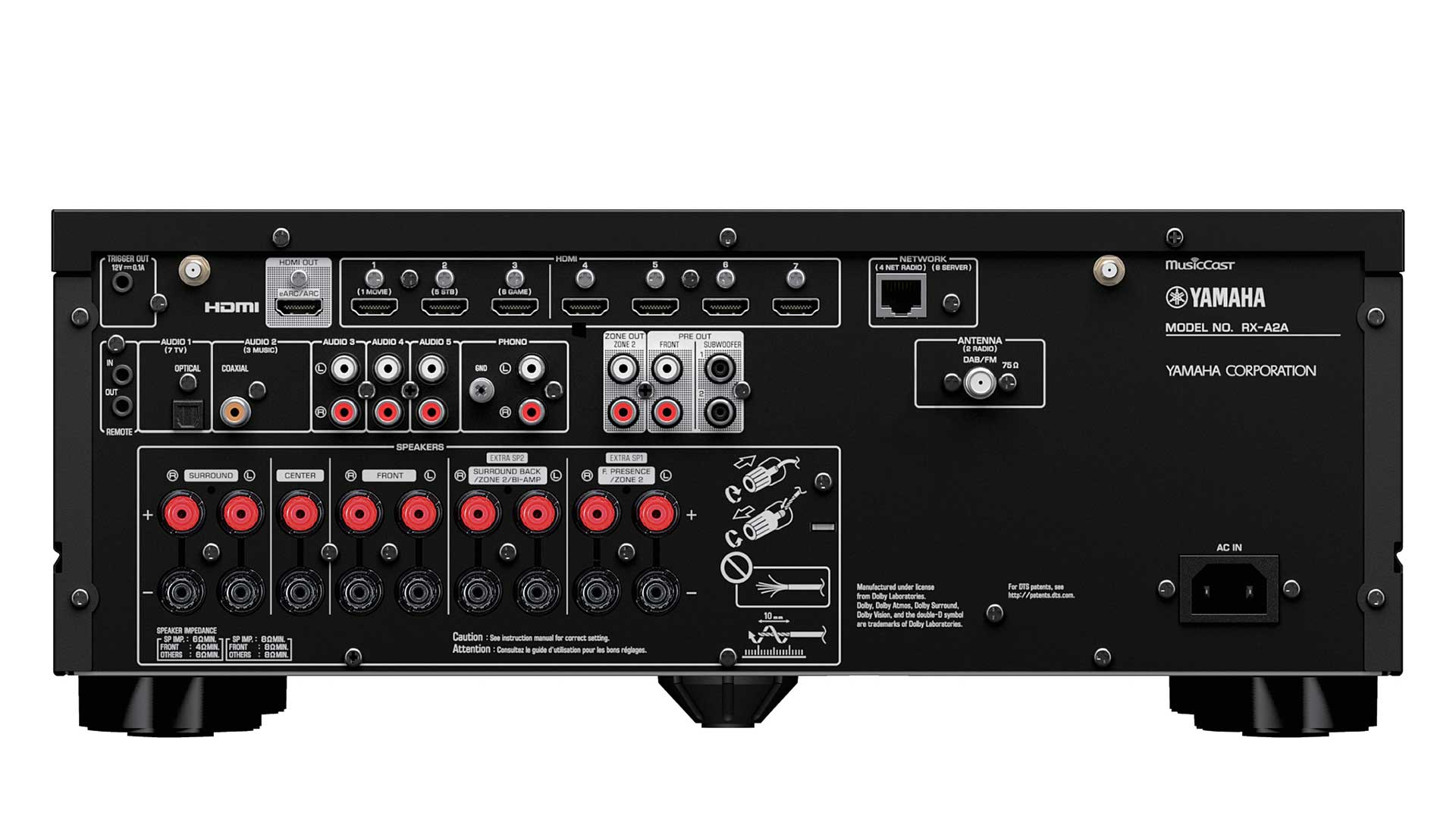
The entry-level Yamaha A2A is already available but stylistically it's still very much part of the Aventage 10 range, with the corresponding streamlining of the front panel and many of the improvements to the structural rigidity.
The most distinguishing feature between it and the more recent addition to the line is the loss of full 8K support. While the rest of the Aventage AVRs will eventually offer 8K support on all seven HDMI inputs, the A2A only stretches to 8K@60Hz on the first three ports when in Display Screen Compression modes. This feature, along with ALLM, VRR, QMS and QFT, will be available after an update that is yet to be scheduled.
Uncompressed 4K video at 120Hz and HDR10+ will be possible via a free hardware update programme that will start in the autumn and last two years, while newer manufactured models will come with the new hardware already installed.
Elsewhere the A2A uses the same DACs as last years Cinema range and while it doesn't have the Qualcomm chipset of its siblings – losing precision EQ and low-frequency mode from YPAO – it still offers the core immersive sound formats of Dolby Atmos, Dolby Atmos Height Virtualizer and DTS:X.
Yamaha's RX-A2A is in the shops now with planned hardware and firmware updates in the autumn.
- Channels: 7.2 ch
- Power output in stereo conditions: 100W (8 ohm)
- High Slew Rate Amplifier: Yes
- Zones: 2
- HDMI: 7-in / 1-out with HDMI 2.1* / HDCP2.3 and eARC
- HDMI Pass-through: 8K@60Hz* (compressed only), 4K@120Hz*on HDMI socket 1-3
- HDMI Up-scaling: Yes up to 4K*
- Surround Sound Processing: Dolby Atmos, DTS:X, Dolby Atmos Height Virtualization*
- DAC: 384 kHz / 32-bit BB PCM5102A
- Room Calibration: YPAO R.S.C. automatic room calibration with multi-point measurement
- Voice control: Amazon Alexa, Siri (via AirPlay 2) and Google Assistant
- Dimensions (hwd): 17 x 44 x 37cm
- Weight: 10.2 kg
MORE
Our pick of the best AV receivers and home cinema amps
Save big with the best TV deals for every budget
Level up your gaming experience with the best gaming TVs
Get the What Hi-Fi? Newsletter
The latest hi-fi, home cinema and tech news, reviews, buying advice and deals, direct to your inbox.
Mary is a staff writer at What Hi-Fi? and has over a decade of experience working as a sound engineer mixing live events, music and theatre. Her mixing credits include productions at The National Theatre and in the West End, as well as original musicals composed by Mark Knopfler, Tori Amos, Guy Chambers, Howard Goodall and Dan Gillespie Sells.
-
Woogy All of these 2021 Yamaha receivers have been delayed due to COVID restrictions at Yamahas manufacturing plant in Malaysia, please refer to here - https://translate.google.com/translate?sl=auto&tl=en&u=https://jp.yamaha.com/news_events/2021/audio_visual/avr_rxa_release.htmlReply
